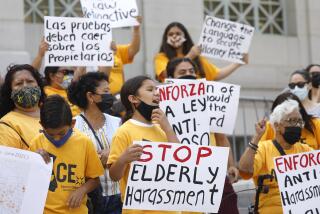There’s little to like about hate-crime laws
- Share via
ACCORDING TO the Los Angeles County district attorney’s office, 10 black teenagers broke the law by attacking three white women in Long Beach on Halloween. But rather than simply charge all of them with felony assault, the D.A.’s office made an unusual decision: Eight of the 10 — seven girls and one boy — were also charged with a “hate crime enhancement” for adding insult to injury with utterances such as “I hate whites.”
Reading about the Long Beach case (which I wouldn’t dare to prejudge even if the facts weren’t so murky), I felt a twinge of vindication.
Four years ago, I wrote that Pennsylvania’s hate-crime law — which, like California’s, is a “piggyback” statute allowing for extra punishment for crimes deemed to be motivated by bias — could have unintended consequences.
For one thing, I believed, such laws could end up giving extra punishment to ordinary criminals who, while committing a run-of-the-mill crime, engaged in some racial trash talk — and that’s not the kind of bias-motivated crime the law was intended to go after. For another thing, it is possible that such laws could end up punishing blacks who commit violence against whites — which is a far cry from the historical experience that inspired hate-crime statutes.
Perhaps even more worrisome, hate-crime laws also muddle the distinction between bad acts and bad thoughts. As I wrote at the time: “If a mugger of one race uses a racial epithet while snatching the purse of someone of another race, is that a ‘hate crime’? Better for the criminal justice system to punish the act — harshly — and not speculate about the motive.”
Bad acts abound in the story of what happened at the Halloween block party. One woman reportedly was hit by a skateboard. Others allegedly were pelted with pumpkins and lemons. But why isn’t it enough for the defendants — assuming they’re the ones responsible — to be charged for what they did, without the additional hate-crime charge?
The best argument against “enhanced penalty” laws is the constitutional one. In the United States, we are taught, you can be sent to prison for what you do but not for what you think. Not only that, if government picks and chooses which crimes are the most serious based on the motivation behind them or the ethnic background of the victim, that is a violation of the 1st Amendment, isn’t it?
That was the message of a celebrated 1992 decision in which the U.S. Supreme Court struck down as a violation of the 1st Amendment a St. Paul, Minn., “bias-motivated crime ordinance,” under which a white teenager had been prosecuted for burning a cross on the lawn of a black family.
The ordinance said in part: “Whoever places on public or private property a symbol, object, appellation, characterization or graffiti, including, but not limited to, a burning cross or Nazi swastika, which one knows or has reasonable grounds to know arouses anger, alarm or resentment in others on the basis of race, color, creed, religion or gender, commits disorderly conduct and shall be guilty of a misdemeanor.”
Writing for the court, Justice Antonin Scalia said that language was too broad. Although it was permissible for St. Paul to punish “fighting words” (and fighting symbols like a burning cross), the law violated the 1st Amendment because it picked and chose among which “fighting words” could land you in jail — those insulting someone on the basis of race, for example, but not sexual orientation or membership in a labor union.
The decision striking down the ordinance was unanimous and seemed likely to doom not only “pure” ethnic intimidation laws such as St. Paul’s but also “piggyback” hate-crime laws (in which the penalty for a crime is enhanced, depending on the motivation behind it).
A year later, however, when a lower court cited the St. Paul decision in striking down a Wisconsin hate-crime law, the Supreme Court refused to follow its own logic and allowed the state’s hate-crime law to stand. Interestingly, the decision in the Wisconsin case upheld the doubling of a sentence for a black man convicted of inciting violence against a white victim.
Hate-crime laws pose another problem. Call it the Jimmy Durante factor. Durante was the 1940s comedian whose catch phrase was: “Everybody wants to get into the act!” And once legislatures began to enact hate-crimes laws, everyone — that is every constituency with political clout — got into the act of agitating to be included in hate-crime laws.
In the 1992 cross-burning case, Scalia noted that St. Paul didn’t prosecute “fighting words” based on sexual orientation, but California’s hate-crime law has no such loophole. It provides enhanced penalties for “bias-motivated violence and intimidation” based on the victim’s “race, ethnicity, religion, sexual orientation, or physical or mental disability.” New York’s hate-crime laws adds “age” to the litany of protected categories. Can veterans be far behind?
The paradox is that as the list of protected groups gets longer and longer, the law approaches a situation in which every crime is a hate crime.
In his opinion in the Wisconsin case upholding “piggyback” hate-crime laws, Chief Justice William H. Rehnquist wrote that the “perceived harms” of racial discrimination justified the state’s imposition of harsher penalties for acts of bias-motivated violence. I obviously disagree, but even if you believe that there should be special punishment for, say, cross-burnings (arguably a unique affront given American history), the addition of more and more groups to the hate-crime laws makes no sense.
One final argument against hate-crime laws: If their overarching purpose is to affirm the equality of all people, then the law should punish all assaults the same, regardless of the race, gender, religion, sexual orientation, disability or veteran status of the victim. The “protected class” should be human beings.
More to Read
Sign up for Essential California
The most important California stories and recommendations in your inbox every morning.
You may occasionally receive promotional content from the Los Angeles Times.











